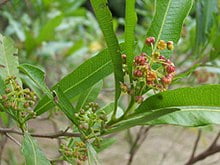Dodonaea

Dodonaea is a genus of about 70 species of flowering plants, often known as hop-bushes, in the soapberry family, Sapindaceae. It has a cosmopolitan distribution in tropical, subtropical and warm temperate regions of Africa, the Americas, southern Asia and Australasia. By far the highest species diversity is in Australia. The genus is named after Rembert Dodoens, traditionally known as ‘Dodonaeus’.
They are shrubs and small trees growing to 1–5 metres (3.3–16.4 ft) tall. The leaves are alternate, simple or pinnate. The flowers are produced in short racemes. The fruit is a capsule, often with two or three wings. Dodonaea species are used as food plants by the larvae of some Lepidoptera species including Aenetus eximia and Aenetus ligniveren.
Dodonaea is one of the largest genera in the Sapindaceae, and includes 70 species widely distributed in continental Australia.[2] The only other species of the Dodonaea widely spread beyond mainland Australia, Dodonaea viscosa, is believed to be one of the world’s most greatly disseminated transoceanic plants.[2]
The first attempts to distinguish infrageneric categories within genus Dodonaea were based on leaf morphology, specifically, two sections – Eu-Dodonaea (simple leaves) and Remberta (pinnate leaves) were differentiated.[2] Later this sectional classification was expanded by Bentham, who included 39 species in five series – four simple-leaved series further divided on capsule-appendage morphology (series Cyclopterae, Platypterae, Cornutae and Apterae) and one pinnate-leaved species (series Pinnatae).
Later the genus has been reviewed extensively two times. Radlkofer identified Dodonaea as a part of the tribe Dodonaeeae, within Dyssapindaceae, together with Loxodiscus, Diplopeltis and Distichostemon. Dodonaea and Distichostemon share similar morphological characteristics which include plants having regular flowers without petals and an intrastaminal disc. Therefore, these two genera are considered to be closely related.[3]
